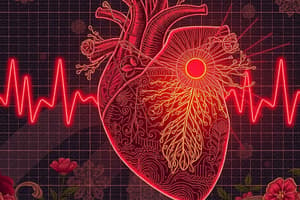Podcast
Questions and Answers
What occurs during the isovolumic contraction phase of systole?
What occurs during the isovolumic contraction phase of systole?
- Blood is ejected from the ventricles.
- Ventricular pressure builds with no change in volume. (correct)
- The heart muscle fibers lengthen without tension.
- The A-V valves open, allowing blood flow.
Under which condition do the aortic and pulmonary valves open?
Under which condition do the aortic and pulmonary valves open?
- When right ventricular volume decreases.
- When left ventricular pressure exceeds aortic pressure. (correct)
- When atrial pressure exceeds ventricular pressure.
- When end-diastolic volume is minimal.
How much stroke volume is typically ejected during the rapid ejection phase?
How much stroke volume is typically ejected during the rapid ejection phase?
- 100%
- 30%
- 70% (correct)
- 50%
What is the end-diastolic volume range for each ventricle?
What is the end-diastolic volume range for each ventricle?
What is the value of the ejection fraction based on the typical stroke volume and end-diastolic volume?
What is the value of the ejection fraction based on the typical stroke volume and end-diastolic volume?
What does the end-systolic volume measure at the end of systole?
What does the end-systolic volume measure at the end of systole?
What can occur to stroke volume with changes in end-diastolic and end-systolic volumes?
What can occur to stroke volume with changes in end-diastolic and end-systolic volumes?
What happens during the period of isometric contraction?
What happens during the period of isometric contraction?
What is the typical value of the stroke volume per heartbeat?
What is the typical value of the stroke volume per heartbeat?
What primarily causes the P wave in an electrocardiogram?
What primarily causes the P wave in an electrocardiogram?
What percentage of the ventricular filling occurs during diastole without atrial contraction?
What percentage of the ventricular filling occurs during diastole without atrial contraction?
How long after the P wave does the QRS complex typically occur?
How long after the P wave does the QRS complex typically occur?
What role do the atria serve in the heart's pumping mechanism?
What role do the atria serve in the heart's pumping mechanism?
What occurs during the period of isovolumic relaxation?
What occurs during the period of isovolumic relaxation?
What causes the T wave observed in an electrocardiogram?
What causes the T wave observed in an electrocardiogram?
Which phase contributes the least to the ventricular filling?
Which phase contributes the least to the ventricular filling?
What happens when the atria fail to function properly?
What happens when the atria fail to function properly?
During which phase does the majority of atrial contraction occur?
During which phase does the majority of atrial contraction occur?
What happens to blood flow into the ventricles immediately before the A-V valves open?
What happens to blood flow into the ventricles immediately before the A-V valves open?
Flashcards are hidden until you start studying
Study Notes
Electrocardiogram Overview
- Electrocardiogram (ECG) records heart-generated voltage from the body surface, representing each heartbeat.
- P wave indicates atrial depolarization, leading to atrial contraction.
- QRS complex results from ventricular depolarization, occurring approximately 0.16 seconds after P wave onset, initiating ventricular contraction.
- T wave reflects ventricular repolarization.
Atrial and Ventricular Interaction
- Approximately 80% of ventricular filling occurs during diastole before atrial contraction.
- Atrial contraction contributes the remaining 20% to the ventricles' filling, enhancing pumping effectiveness by 20%.
- Atria dysfunction may lead to significant symptoms like shortness of breath during exercise but usually remain asymptomatic at rest.
Diastole Phases
- At the start of diastole, A-V (atrioventricular) valves are closed; atria fill with blood during systole.
- Isovolumic relaxation occurs as ventricles relax, leading to decreased pressure.
- A-V valves open when ventricular pressure falls below atrial pressure, allowing blood flow into the ventricles.
- Rapid ventricular filling occurs in the first third of diastole, providing most volume, followed by continuous filling.
- Atrial contraction, termed “atrial kick,” happens in the last third of diastole, contributing 20% of ventricular filling.
Systole Mechanism
- Systole begins with ventricular contraction, closing A-V valves and increasing ventricular pressure.
- Isovolumic contraction occurs when no blood is ejected, and fetal volume remains constant while pressure builds.
- Aortic and pulmonary valves open when left ventricular pressure exceeds 80 mm Hg and right ventricular pressure surpasses 8 mm Hg, allowing blood ejection.
- 70% of the total blood ejected from the ventricles occurs during the rapid ejection phase, while 30% happens in the slow ejection phase.
Ventricular Volumes and Ejection Fraction
- End-diastolic volume, the volume in each ventricle at the end of diastole, ranges from 110 to 120 milliliters.
- Stroke volume, the amount of blood ejected per beat, is approximately 70 milliliters.
- End-systolic volume, remaining blood post-ejection, measures around 40 to 50 milliliters.
- Ejection fraction is calculated by the formula: Ejection Fraction = Stroke Volume / End-Diastolic Volume, typically around 60%.
- Stroke volume may be increased by elevating end-diastolic volume and reducing end-systolic volume.
Studying That Suits You
Use AI to generate personalized quizzes and flashcards to suit your learning preferences.




